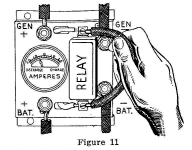Connect the generator cable (A-109) to the terminals on the left side of the generator. Be sure that the red wire of the cable is connected to the positive or insulated terminal of the generator. This terminal has a 1/4"x 24 thread hex nut and lock washer. The black wire of the cable is connected under the larger of the two round head screws. This is the negative or grounded connection. The letter "G" is stamped in the frame near it. DO NOT DISTURB THE SMALLER ROUND HEAD SCREW.
Pass the cable under the generator cable clip (A-113) in such a way that it has a free bend when the generator is raised.
Place the hub spinner (A-102) in position over the hub. Then mount the propeller (C-205) with the flat side of the blades forward. The nose plate (A-107) goes on the front side of the propeller.
After the propeller has been mounted, measure straight out from the tower to one blade tip. Now turn the propeller over and measure out to the other blade tip. These distances should be equal within 1/8". If they are not equal, loosen the bolt on side on which the tip is closest and tighten the other bolt more. Both bolts must be tight when the mounting is complete.Should you still be unable to make the propeller track, you will have to loosen both bolts and place a small tin or cardboard shim between propeller and hub to make it line up properly.
After completing your installation throw the charger out of gear and polarize the generator. Take a piece of wire and short across the relay as shown in figure 11. This will cause the generator to motor. It may be motored for a minute or so.

Under normal wind conditions the power plant will keep the battery charged. However, much depends on the wind speed and the amount of current drawn from the battery. Should you have several days in which the wind does not exceed 8 miles per hour, and you continue to use current, the batteries may become discharged. The following table shows the approximate charging current of Models 206 and 212 power plants at various wind speeds.
| Wind Speed in M.P.H | Model 206-Amperes | Model 212-Amperes |
| 8 | 3 | 1.5 |
| 12 | 9 | 4.5 |
| 16 | 15 | 7.5 |
| 20 | 18 | 9 |
| 24 | 20 | 10 |
The charging rate of the generator is affected by the battery voltage. A dead battery has low voltage and the generator fields will not be so strongly excited as when charging a partly charged battery. For this reason, the charging rate for a dead battery will be less than for a partly charged battery.
As the generator warms up, the output decreases. This is a normal behaviour of all generators. Your generator may deliver peak outputs 15% to 25% higher than normal when started cold, but after running for an hour the peak charge will be about as shown in the table above.
| << Previous Page | Return to Home Page | Next Page >> |